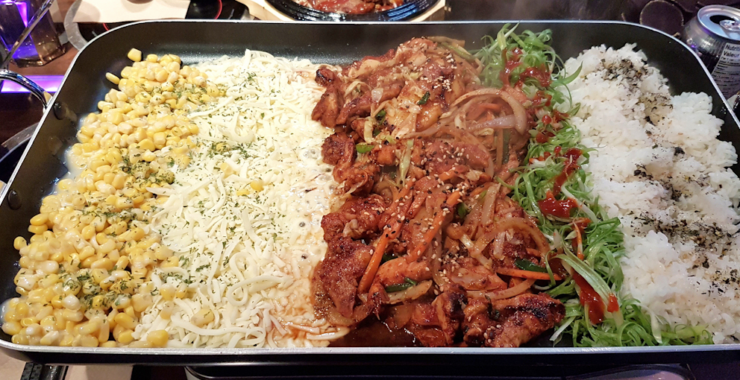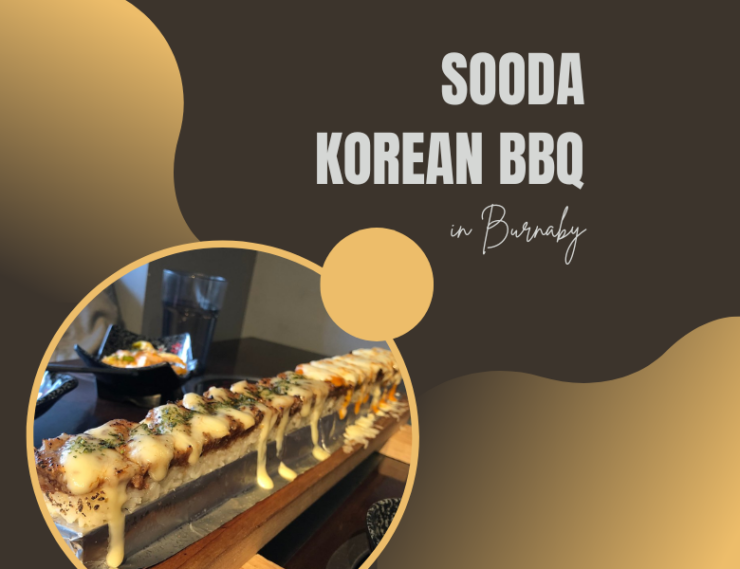I’m sharing this with you because I am by no means an expert when it comes to Asian cuisine. But I was so pleased to discover that there is a great bbq restaurant in Chinatown, right under my nose: Sooda Korean BBQ (33-15 East Broadway, Vancouver).
Having tasted their bbq and sauce, I can confidently say that it is the best in the city.
They are open for only 4 hours on the weekends (closed for lunch), but it’s worth it. Their food is extraordinarily tasty and their service is quite friendly and attentive. If you want to try their bbq without a reservation, they open at 5 pm on weekdays too; however, if you want to make sure you have a seat when they open just call ahead (604-353-5678).
They also have an online ordering system – which I use all the time when going out for takeout/pizza/brunch. It works like this:
1) Visit: https://www.sodakoreanbbq.com/order2
2) Create your own personalized order
3) Select your delivery time and location in Canada (Vancouver or Toronto) – then create your own delivery address or pick one of Sooda’s pick-up locations – then select “Payment” so they can deduct the delivery fee from your charge card 3a) Pay with cash or Visa Card 3b) Pick up your order at any Sooda location or give them one of their picks up locations at an off-peak time They will email you all details about your order, including photos of your meal Once everything gets processed from 3a to 3c, they will send you an email telling you what’s left on your order 4a) Print out the receipt 4b) Bring it back to Sooda Korean BBQ for pickup 4c) They will be happy to take care of everything 6a) Use Sooda’s online ordering system 6b) Use Sooda’s online ordering system unless otherwise noted 6c) Give them a tip once in awhile If you don’t have time to wait till 5pm, use Sooda’s online ordering system! You can still get some great deals while waiting! They also work on both mobile phones and tablets.
Review the Product

This is one of the most common questions I receive, and I honestly don’t know how to answer it well.
The decision that you make about the name of your product should be based on a few things.
The most important consideration is: can we reach out to a large enough audience with this name? Can we come closer than any other product in the market? And do we need to?
If, for example, your product has a name that starts with “Sooo” and anyone who sees it would immediately think: “So-Da” (or “Sooo-Da” or “Slooooo” or something similar), then you can probably skip the rest of this post.
If your product has a name that starts with “Soo-Da” and no one recognizes that name at first glance, then you probably have one of the more difficult names for marketing. It might be worth considering skipping some of this section, but if so: ignore everything after this point until you have sorted out what to do once you decide on a name.
If your product is named as such by default (because people don’t think of any other names), then there are two options: change your mind and re-name; or stick to your original plan, but change the name.
This choice will not be easy (if it were easy we wouldn’t have problems naming our products), but it’s important to remember that if you’re getting into selling products for profit, then keeping brand values in mind is just as important as whether or not people recognize your product’s name at first glance. So change nothing unless absolutely necessary.
Changing your mind leads us into another discussion though – why do we want to change our minds in the first place? Unfortunately changing our minds is difficult enough without considering all possible outcomes – let alone trying to figure out how likely they are! Let’s consider them one by one:
A big reason why changing our minds is hard is because there are so many potential outcomes – everything from people dropping off completely over time (and therefore giving up buying) to users finding other solutions entirely (which means they won’t give us positive feedback).
The second reason why changing our minds might be hard is because if people don’t like our product for some reason or another, then they could simply stop using it entirely and stop paying for it altogether; which would mean losing profits and revenue alike (
Consider the Ingredients

In the past few years, Korean BBQ has become much more popular in the West. The reason is undoubtedly due to the fact that it tastes better than the other types of Korean bbq.
So I started researching Korean BBQ and found a lot of good information online, but I was still confused about what to look for in a good bbq restaurant. I made a list of ingredients, ingredient categories, cooking methods and more sooda Korean bbq restaurants should have at least these:
1) Price: A good bbq costs between $10-$20 per meal and depending on where you are in Korea you can get really good food for as little as $5 per meal.
2) Quality: A high-quality bbq will be meaty, flavorful and tender (especially the longer you cook it). If the meat is under-marinated or overcooked it will taste bad because it won’t have enough flavor or flavor-boosting nutrients that help make meat delicious. Also, make sure there isn’t too much fat/oil on the meat or it will be greasy/oily.
3) Taste: You want a bbq with a very “smoky” flavor that is balanced by other flavors like garlic and onions. You don’t want any overpowering spices like chili paste (which adds an artificial taste). Make sure your food tastes good! Good BBQs taste like they came from a restaurant whereas cheap ones taste more like eating out of a bag (especially if you are using instant noodles!). And if you are feeling ambitious then try leaving your mashed potatoes on top! … just kidding 😦
4) Size: There are two types of sooda Korean BBQs: small/medium-sized ones, which can fit into one bowl ($20), or large ones which have larger bowls ($25). Smaller ones tend to be better for travel; larger ones tend to be better for parties of 4+ people ($30).
The above items represent all ingredients found at sooda korean bbq restaurants; here I am listing only those which I personally consider very important in order to achieve high-quality Korean BBQ: [1] Price : Better than average prices are usually around $5-$10 per meal, but some places offer such great deals that you can get meals for as little as $0.50/$1 if you pre-order from them
Know Your Audience

If you have read the last few posts, you will know that each one of them has been on a different topic. The purpose of this post is to set a single example for all the topics covered in the previous posts. I think it’s important to have this as an overarching theme for each post and also as a reminder that we are not limited to one particular type of brand communication (e.g., direct-response or social media).
First, let’s apply our findings from the last few posts on the topic of brand communication strategies:
• Brand storytelling
• Branding and identity design
• Brand positioning
• Tracking and measurement
• Retargeting marketing
• Social media (and more)
With those basics out of the way, we can begin to look at each topic separately. Each has its own unique characteristics and nuances that must be considered when applying these ideas across a range of channels. But there are some commonalities in their application: They are all social-media driven and use various methods to track audiences online as well as offline (e.g., lead generation, sales, etc.). They all deal with identity and branding – they want to be known by their audience (and if they aren’t known by your audience, brands should be very worried).
They all use metrics-based approaches such as conversions (or perceived value), engagement levels, etc. which can provide useful insights into how well their products are being received by their audiences.
And, they all require some form of measurement to enable them to understand how well they’re doing with their audiences across various channels – whether it be website traffic or conversion rates or email open rates or whatever metric is appropriate for a given channel (the question isn’t whether it can be done, but whether it is possible given your market/audience/marketplace).
So what are marketers doing wrong? What mistakes do brands make? Why aren’t these problems unique to large companies but happen with smaller brands too? What types of things should marketers do differently from brands? What sort of things should brands do differently from marketers? And how can one effectively integrate these different approaches together for maximum ROI? Well firstly – here are some mistakes that small businesses make when trying to build brand awareness: misspelling “sooda” instead of “soodae”; not capitalizing “sooda
Business and Marketing Strategy

This is a bit of an ad-hoc post, as I was going through some old notes. But it’s a very good example for such a case: sooda korean bbq.
At the time, I was doing marketing for a company that had built a large online business selling (as pork buns) a particular pork product. The product was not well-known in Korea and the sales were slow. We needed to get the product out there and give it an identity, just as with any other brand name.
This was not an obvious idea: we built an e-commerce site that would allow our customers to buy sooda Korean bbq (soodakoreanbbq). That site also allowed them to search for specific products by type of pork and its various uses. Sooda Korean bbq (soodakoreanbbq)
We launched it in June 2011; at first glance, it looks great: the photos look great (and they were taken by our own photographer), and the branding is very good. The thing that makes this launch special is that it took place on the South Korean Independence Day holiday weekend — basically 2 weeks before Christmas 2011. That weekend is usually one of the busiest days in Seoul, but we had no trouble attracting business on that day!
Each launch went very smoothly; people bought into the product idea and bought their first order around Christmas 2012. As far as I know, there have been no issues with stock or logistics since then — even though we’re still working hard at making our brand more recognizable in Korea and Japan.
The short-term outcome? A fantastic success story with fast growth – millions of dollars in sales + excellent customer support – all under pressure from just one small startup going after its target market! If my memory serves me correctly
Conclusion
I’m not sure if the above summary is helpful for those of you who are just starting out with writing blogs. It’s about a quarter of the way through the process and I don’t think I have any more to say.

